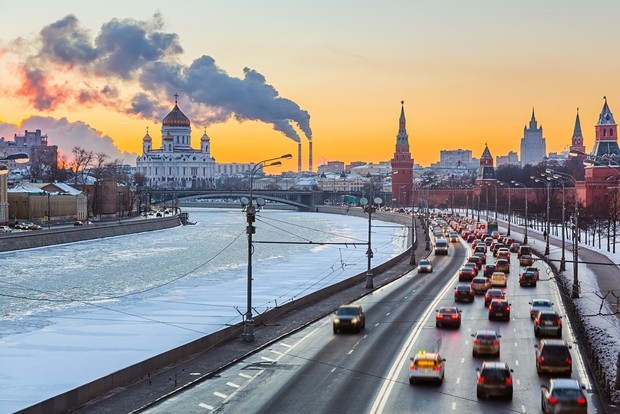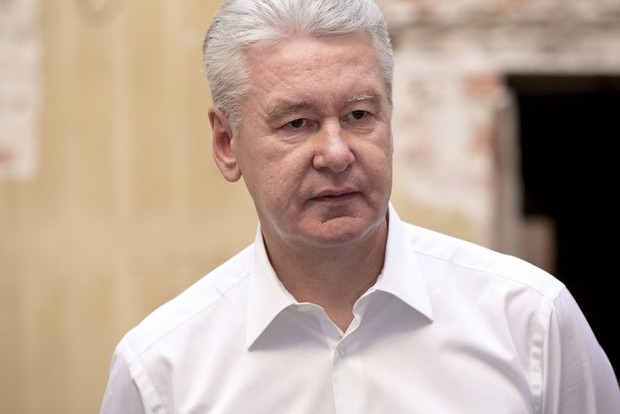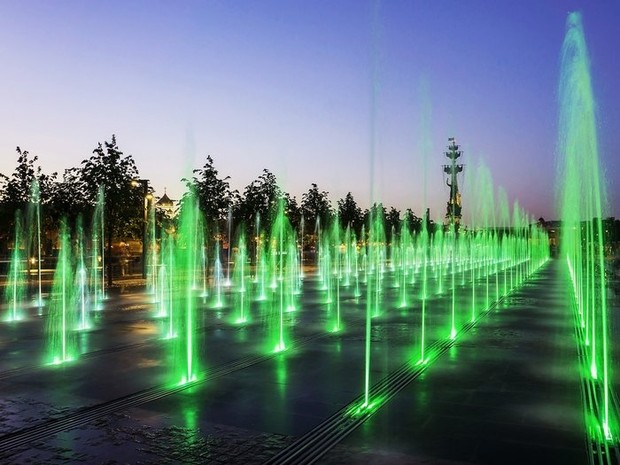Moscow Reconnects With Its River

Much of Moscow’s riverfront is a concrete barrier of roads, parking and industrial sites. Mayor Sergei Sobyanin has big plans to make it green.
MOSCOW, Russia — Barely a mile from the Kremlin, an unusually warm winter evening here draws a crowd to hang out along the bank of the Moscow River.
Small groups of people sit on benches along the promenade, drinking mulled wine and eating sandwiches bought from pop-up food stands, while others gather around a bandstand where local indie music groups often perform. The river itself is quiet, and parts of it are still frozen, but even in summer there is not much river traffic, save for some sightseeing boats.
This is the Crimean Embankment, known locally as Krymskaya Naberezhnaya. The 4.5-acre (1.8 hectare) site was fully pedestrianized just over a year ago. Parking spaces for cars and a busy roadway were replaced with a quay, fountains, sun loungers, bike rental facilities and a boardwalk. A decommissioned cruise ship docked here offers boutique shopping and educational spaces, while artists sell paintings at a refurbished open-air market. The site immediately became a popular destination for skateboarders, cyclists and other city dwellers wanting some respite by the water.
Not long ago, this sort of public space was hard to imagine anywhere in Moscow, let alone by the river. Known as the Moskva, the waterway has long been severed from city life. For the most part, the river is a concrete-bound channel whose embankments are used for roads, parking or industrial purposes.
Mayor Sergei Sobyanin is intent on changing this. And making over this 1-kilometer stretch of riverfront is just the beginning.
Last fall, Russia’s capital sponsored an international design competition to re-imagine what the whole river and its surrounding areas could look like 20 years from now. The winning plan, by a consortium led by the Moscow-based architecture firm Project Meganom, envisions a green waterfront with both sculpted parks and more natural spaces. It also imagines new transportation links, both on water and land, that put the river at the heart of Moscow’s future.

In recent years, the Moscow government has paid increasing attention to improving the quality of life for city residents, particularly through the development of cultural and recreational areas. Several streets in Moscow’s historical center have become fully pedestrianized — a rare victory for people over cars in the battle for city space. An ambitious makeover of the Gorky Park has turned a place that once was to be avoided into a model park whose biggest problem is coping with a crush of visitors.
“I know firsthand that walking along the river is no fun.”
Sobyanin sees the river plans as another key piece of this livability strategy. It’s also part of how Moscow hopes to compete against other European capitals in the global race for business, talent and jobs. Sobyanin put it this way in a December interview with news channel Russia-24: “I believe that improvement of public spaces is likely to give the city a competitive advantage.”
“Forsaken spaces”
Moscow’s rivers were crucial to the city’s early development. In the mid-18th century, the city’s first industrial zones and factories were located along theMoskva and Yauza rivers, enabling raw materials to be shipped in and finished goods shipped out. Although Moscow long ago ceased to be a center of industry, dilapidated plants remain: Industrial zones account for about a quarter of Moscow’s 200 kilometers of riverfront.
Many residential districts are also situated along the Moskva, but a lack of recreation zones, amenities and access to the waterfront mean that the river is not part of life in the city.
“As a resident of a building that faces the river, I know firsthand that walking along the river is no fun,” says architect and urbanist Nadia Nilina. “First of all because it is nearly impossible to cross over the highway that severs the river from the city.”

Getting from one side of the river to the other is not easy either. Bridges are few and far between—some are spaced as far apart as 14 kilometers. London and Paris have twice the number of pedestrian bridges as Moscow, despite having smaller populations.
River pollution is also a problem, despite the fact that there aren’t many active industrial facilities along the river. Particularly in the city center, storm drains carry melting snow, road runoff and silt into the river. That makes waterfront locations even less inviting.
“They are forsaken spaces, abandoned by the city,” photographer Natalia Melnikova told the Architectural Council of Moscow after shooting a series of pictures of Moscow’s riverfront factories. “There is car traffic and technically there are sidewalks too, but nobody ever uses them.”
Port of the future
The Crimean Embankment project showed that this could be changed. Building off its success, Moscow officials staged the design competition to begin an even bigger conversation about what the river could become. Held by theMoscow General Planning Research and Project Institute, the state agency in charge of territorial planning, the competition was the largest in the city’s history.
The plan also aims to turn space for cars over to people.
The design area covered more than 10,000 hectares (39 square miles). The goal was to make the Moskva’s embankments more accessible, to connect areas located close to the water and to make the river a focal point of the city. Thecompetition’s brief used examples from waterfront revitalization projects in Oslo, Hamburg, Bilbao, and cited master plans for Paris’ Seine, Berlin’s Spree and London’s Thames Gateway as successful precedents for integrated river development.
“People should be able to walk along the river, to access it easily,” Moscow Chief Architect Sergei Kuznetsov told local radio station Vesti FM recently. “We have to create pedestrian and cycling routes, improve the territories that are abandoned, littered or misused. It’s important because wastelands like this turn into breeding grounds for criminal activity, stray animals and pollution. They have to be cleared, cleaned, and redeveloped.”

Kuznetsov was part of the jury that picked Project Meganom’s entry from among six finalists. The winning concept is called “Port of the Future.” The term “port” is meant to signify not only new transit, walking and cycling connections but also serve as a metaphor for the numerous focal points that would develop along the river—a new typology of public space for Moscow, where the city meets the river.
The plan proposes creating 11 large ports and 26 smaller ones. At each location, the master plan introduces a combination of several simple “activation strategies.” These include increasing the amount of greenery, beautifying the embankments, creating landmarks and introducing basic amenities that are currently lacking such as toilets, snack bars and benches.
“The idea is to bring some value to places near the river,” says Project Meganom’s Anna Kamyshan, the proposal’s project manager. “They are tools to make the river more active. They all work together.”
The strategy is ecologically focused, paying a lot of attention to landscaping and proposing to incorporate wetland parks on the urban periphery. In the city center, a lower-level embankment with plants would also introduce more greenery and serve to filter water flows into the river, Kamyshan explains.
The plan also aims to turn space for cars over to people. Roads along the river would be pushed back and replaced with promenades and cycling paths. The river itself would be the city’s new central street, with 120 kilometers of green embankment by 2017. Rather than building new bridges across the river, a new focus would be placed on developing water transport.
“I think it’s more of an ideological statement,” Kamyshan says. “There has never been a design proposal for all of the river’s coastal territories. So I believe it’s the first step towards opening the river to the city’s inhabitants, and of course, it’s not the last one.”
Implementation and obstacles
Now, the focus is turning to implementation. As the competition’s winner, Project Meganom will be invited to be a consultant in the city’s efforts to revitalize its riverfront, though chief architect Kuznetsov has said that ideas from all six finalists will be incorporated into the city’s final plans.
Some doubt whether the city can follow through on its big visions. The economy here is weak, dragged down by international sanctions against Russia. Inflation is taking off and the ruble has fallen in value against the U.S. dollar by almost half in the past year. Meanwhile, the city has other commitments, such as developing “New Moscow,” a massive territory absorbed by the city in 2011.
“I have serious doubts that the enthusiasm associated with the newly discovered discipline of urbanism in Moscow will last much longer,” says Nilina, who also took part in the competition with the Dutch urban design practice Maxwan. Nilina also highlights the unclear and sometimes conflicting goals of city authorities and a lack of communication between departments.

“To achieve serious results in the redevelopment of the post-industrial zones on the river, broad consensus between the developers and the administration must be achieved,” she says. “We need strong alliances built, where the city is responsible for the protection and multiplication of the ’public good’ and the developers have clear rules and incentives to implement serious projects in the city.”
Project Meganom’s Kamyshan echoes Nillina’s concerns. “We need new investment models,” she says. “Those places belong to the city. They basically have to be developed using city money, and these sums are huge. They just can’t do it. They can only afford to do one small area, like the Crimean Embankment, and that’s all. The outskirts of the city center stay untouched.”
Zoning rules will also need to be changed to realize Moscow’s riverfront ambitions. Many areas along the river are not zoned for commercial and mixed-use developments. Only certain functions, such as schools, are allowed at other sites. As Kamyshan says, “If you aren’t allowed to build anything, how can you ask investors to pay for anything?”
Mayor Sobyanin says these problems can be overcome. Developing tourism, culture and recreation remains a priority for Moscow, even in lean economic times, he says. “Many say that this is not the right time for improvement projects, such as parks, pedestrian-only streets and squares, and open spaces, and suggest mothballing all of them,” he said in the interview with Russia-24.
“If we want to attract people and investment and have a sustainable economy we should not cut investment — rather we should encourage more investment to make the city comfortable and people-friendly.”
This story originally appeared on Citiscope.
- Tags:
- Urban Design




